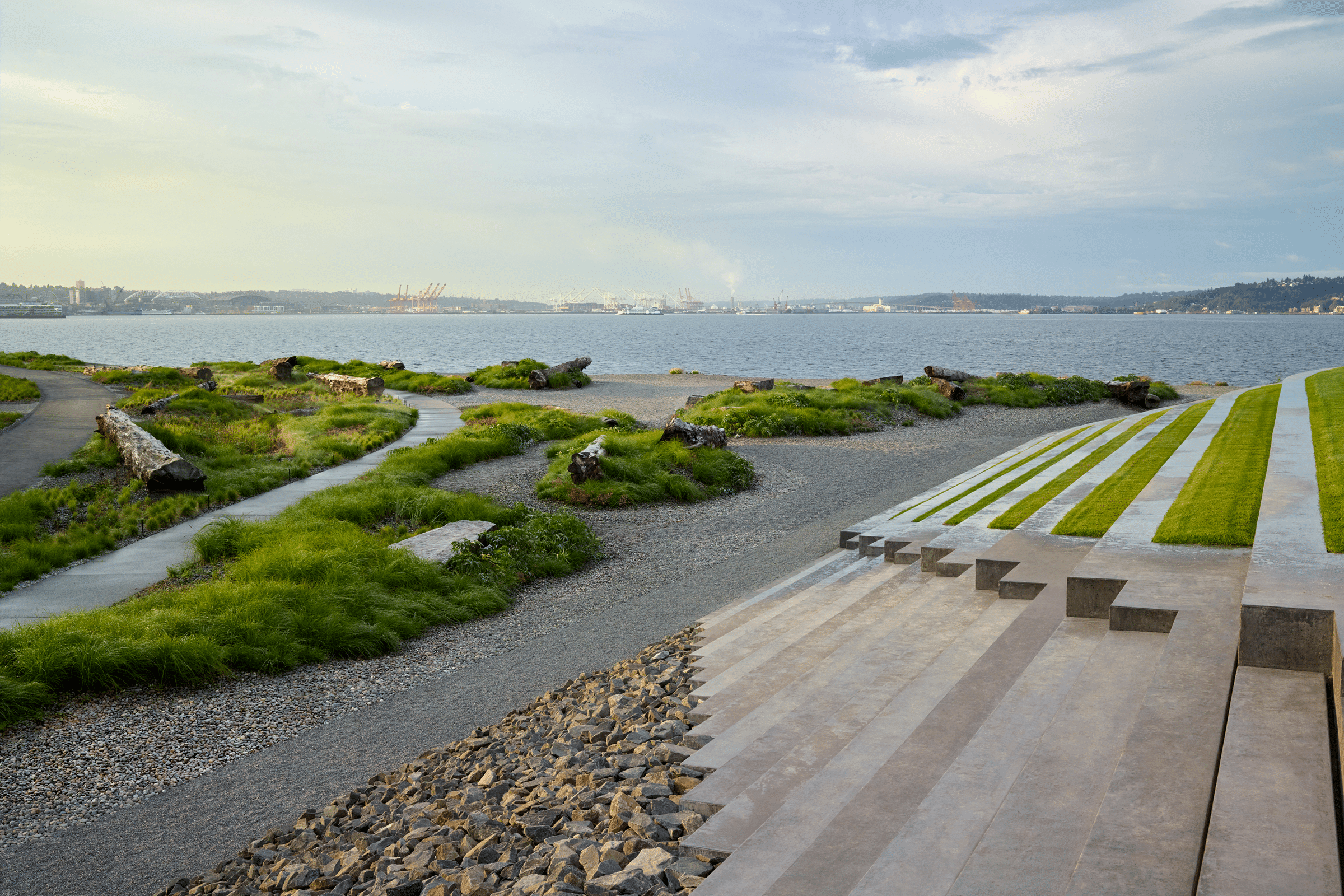Story at a glance:
- Sustainable landscapes can sequester carbon and clean the air and water.
- The use of products like turf and permeable pavers can help save water
- Switching to battery powered equipment helps improve the health of the environment and people.
Whether you’re working on your backyard or sculpting the landscape around your latest commercial project, doing so in a sustainable way is important. “Sustainable landscapes are responsive to the environment, regenerative, and can actively contribute to the development of healthy communities,” according to the American Society of Landscape Architects (ASLA). “Sustainable landscapes sequester carbon, clean the air and water, increase energy efficiency, restore habitats, and create value through significant economic, social and environmental benefits.”
Landscape architects can help create outdoor spaces that are both beautiful and good for the surrounding ecosystem.
“Landscape architects use climate positive design approaches that transform parks and open spaces into natural carbon sinks. They develop resilient nature-based solutions that reduce the impacts of extreme heat; coastal, ground, and inland flooding; sea level rise; pollution; and wildfires. They also increase biodiversity and protect and restore ecosystems, which underpin life on Earth,” according to the ASLA.
If you’re looking for sustainable landscaping ideas, there are many techniques and products that can help. Here are some highlights.
1. Plants
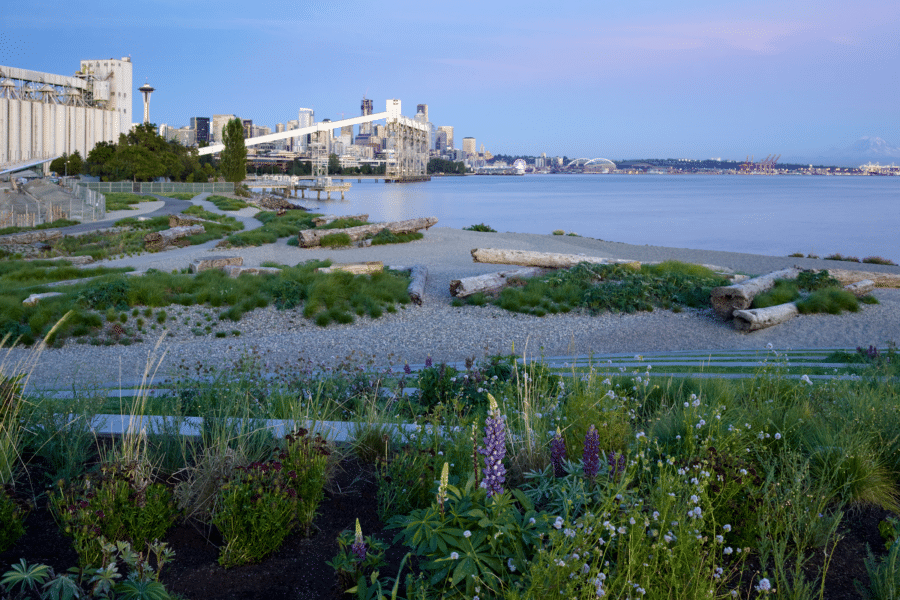
Expedia Group commissioned Surfacedesign to improve public enjoyment of its headquarters’ 2.6 waterfront acres. Photo by Marion Brenner
Of course plants are the most important element of any landscape or yard, but what are the most sustainable ways to incorporate them? The first step is to assess the existing plant life of a space and keep as much of the native species as possible. Doing this can reduce the noise pollution that would occur if you were to remove those plants, protect the animals and insects that rely on them, and build upon the existing landscape with fewer costs.
The Beach at Expedia Group is one example of this. This landscape is at the edge of Elliott Bay on Puget Sound, just north of downtown Seattle, and features native plant life and reclaimed materials.
Due to its location along Elliott Bay, special attention was paid to plants that provide wildlife habitat. Perennials like fireweed, flax, and goldenrod attract insects that are eaten by salmon. A mix of native and adapted tree species weave between the paths and were selected for their hardiness, shade, habitat, and seasonal interest, from Oregon ash and Oregon white oak to lodgepole pine.
“Along the public waterfront paths, a vibrant coastal-meadow palette creates a seasonally varied horticultural experience as visitors move through the site. This planting is a mix of seven native meadow grasses with pink, purple, and yellow native perennial accents that flower throughout the year,” Michal Kapitulnik, a partner of Surfacedesign, told gb&d. “These tonal palettes are arranged in bands, creating a series of rhythmic thresholds for visitors as they move along the waterfront.”
Researching and incorporating native plants can ensure that your project will work well with the area’s natural ecosystem and foster a healthy environment. Creating a diverse natural landscape with a variety of species from the area is both visually pleasing and beneficial to wildlife. Another way to do this is by eliminating the use of toxic pesticides in your landscape.
2. Green Roofs

Archatrak’s Oak porcelain pavers with pre-grown plant trays at the International Spy Museum in Washington, D.C. Photo courtesy of Archatrak
Installing a green roof can be a big bonus for both commercial and residential projects. The green roof market is projected to grow at a compound annual growth rate of 17% from 2020 to 2027, and the market is projected to reach $4.2 billion by 2027, according to Grand View Research. Green roofs can reduce temperatures and urban heat island effect, regulate rainfall runoff into stormwater drains, increase plant biodiversity that provides a habitat for insects and birds, and protect the roof membrane.
There are a variety of products that help support a healthy green roof. Some of these include waterproofing membranes, engineered growth media, drainage systems, and even modular plant trays. “Modular plant trays eliminate the need for drainage mats, water retention mats, root barriers, and filter fabric—all necessary components of growing plants directly on a rooftop,” Malcom Kay, the CEO of Archatrak Inc., previously told gb&d.
Kay says with a tray system, you have the option of “pre-grown,” where the trays are supplied already filled with growing medium and planted with species like sedums; or “planted-in-place,” where empty trays are laid on the rooftop and then filled with growing medium and plants. “Pre-grown tray systems typically require a green roof’s design to be planned in advance and must be installed immediately upon arrival on site. With planted-in-place tray systems, you can install the green roof in phases, as empty plant trays and sacks of growing media are shipped to site and rolls of sedum plantings are shipped separately, which offers more design flexibility.”
3. Planters
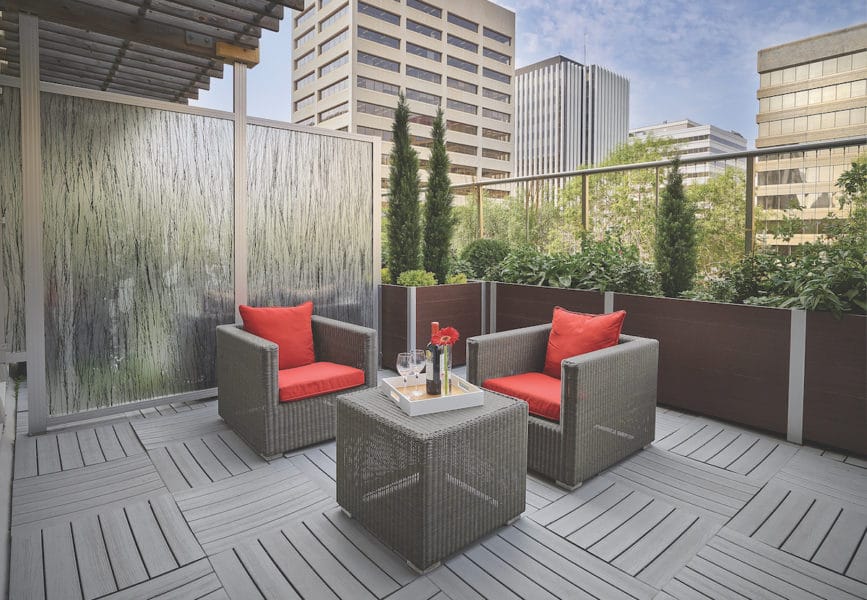
DeepStream Designs uses recycled materials wherever possible. Photo courtesy of Matrix Hotel Edmonton
Planters can also add to your sustainable landscape design. Planters can be durable, recycled and recyclable, and provide design flexibility—whether that’s on a roof or in a garden.
DeepStream is making rooftop installations simpler and more cost-effective with their customizable, modular planter systems. DeepStream uses recycled materials, like recycled plastic lumber, wherever possible. In fact, products made with recycled plastic lumber made up 62% of DeepStream’s sales in 2017.
While wood-on-wood planters gradually tear themselves apart, DeepStream uses marine-anodized aluminum legs and stainless steel fasteners to clamp the wood so it can expand and contract without damaging the structure. And the planter’s legs are protected from the wet ground by using HDPE plastic feet.
“One of the reasons I designed the planter system like I did is that they last,” said Tom Boyce, founder of DeepStream Designs, in a previous gb&d article. Expected to last for decades, the planters are also easy to repair and refurbish, so you won’t have to redo your project every few years. All it takes is sanding off a little of the planks’ exterior and cleaning the aluminum to make the planters look like new.
4. Green Walls

Photo courtesy of greenscreen
Green walls can also be used to elevate both residential and commercial projects in meaningful ways. Green walls support biophilic design by purifying the air and creating an oasis in an indoor or outdoor space.
Greenscreen specializes in green facade solutions and created a green facade for the mostly industrial area on the Duwamish River in South Seattle. The Duwamish Valley greenscreen green facade is, in the words of the community, “a green wall without a building,” and was voted the top “most effective option for mitigating air pollution.”
This expansive green wall project is just one example of the benefits that green walls can bring to communities.
Green facades and walls can mitigate air pollution and be installed anywhere, according to Reuben Freed, a green wall consultant and the former director of research at greenscreen. He says their green walls don’t require a building for support, are easy to install, and will thrive with minimal maintenance and locally viable vines.
5. Permeable Pavers
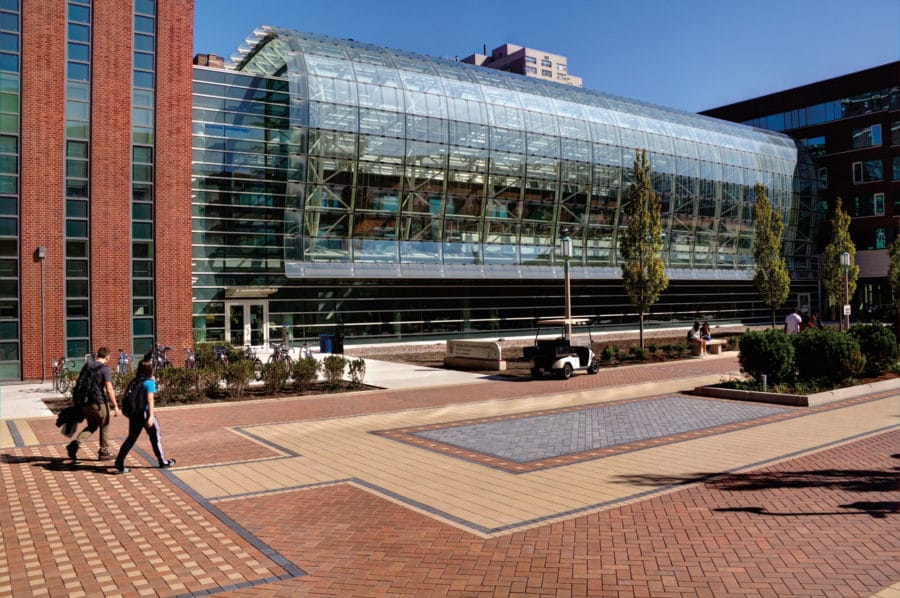
Photo courtesy of Unilock
Permeable pavers can help outdoor spaces save water and offer designers a modern look. Permeable pavers are paved surfaces that allow stormwater to infiltrate back into the subgrade as it falls, unlike impervious concrete and asphalt surfaces that channel runoff into rivers and streams, creating a host of environmental issues and contributing to downstream flooding.
“Permeable pavement can reduce the concentration of some pollutants either physically (by trapping it in the pavement or soil), chemically (bacteria and other microbes can break down and utilize some pollutants), or biologically (plants that grow in-between some types of pavers can trap and store pollutants),” according to the USGS. “By slowing down the process, permeable pavements can cool down the temperature of urban runoff, reducing the stress and impact on the stream or lake environment.”
Unilock offers custom manufacturing for large installations of permeable pavers. One example of this is at Chicago’s Navy Pier. During the redevelopment, a SITES-certified project designed by James Corner Field Operations, Unilock used copper slag for 30% of the concrete paver mix.
Porous pavement is also an option for infiltrating stormwater runoff. However, these products have a tendency to quickly become clogged and cannot be readily cleaned out. When permeable pavers get clogged, the problem is easy to fix, says Elaine Willis, director of commercial strategy for Unilock. “You can often just vacuum out the clogged joint material and that takes care of it. At worst, you may have to pull up some of the pavers and replace the aggregate, but you are able to reuse the same paving stones. With pervious asphalt, you have to replace it entirely if it becomes clogged.”
6. Turf
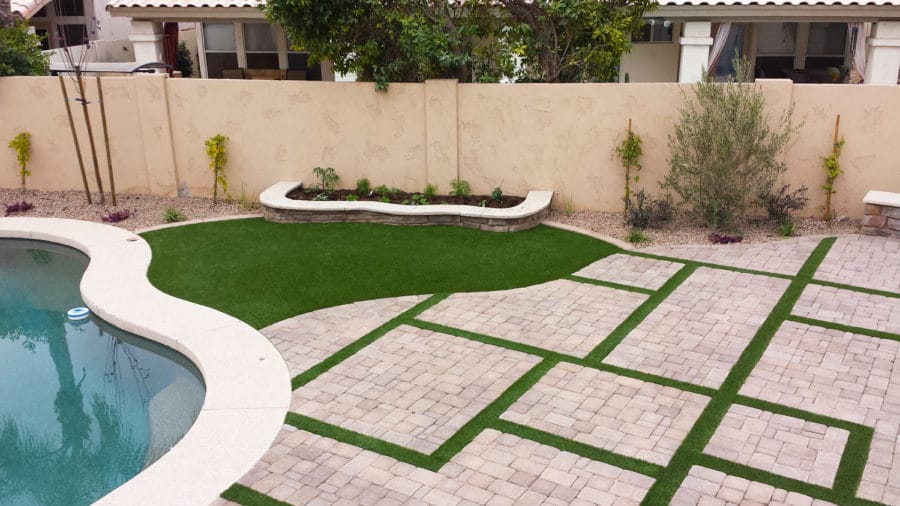
ProGreen recently launched a commercial dual-fiber product that’s extremely durable. Photo courtesy of ProGreen
Depending on the design, you might also consider turf for your project, as it can easily cut down water usage. “Office buildings, schools, hotels, hospitals, restaurants, and other commercial and institutional facilities use a significant amount of water and energy in their daily operation,” according to the EPA.
Turf can also help earn commercial projects LEED credits, as outdoor water efficiency alone can earn up to 4 LEED credits.
Turf comes in a variety of forms, including ForeverLawn’s K9Grass—artificial grass designed specifically for dogs. The turf company also manufactures Playground Grass Ultra with XStatic antistatic technology—making it safe for all kids to play, even those who rely on electronic devices like cochlear implants, as the invention reduces static buildup. “We can create playgrounds that are accessible for children who were otherwise left out,” says Jim Karmie, landscape brand manager for ForeverLawn.
ProGreen’s American-made turf is another option, and it doesn’t require any chemical maintenance, which means there’s no potential for groundwater contamination. “It’s a very consistent, reliable surface that holds up to traffic and use,” says Justin Reddy, president of ProGreen. Turf also eliminates dragging mud into your facility or having trip hazards when the ground is frozen. ProGreeny makes all of its fibers in Alabama, and they only buy blue chip domestic resins that are free of heavy metals.
7. Maintenance Equipment
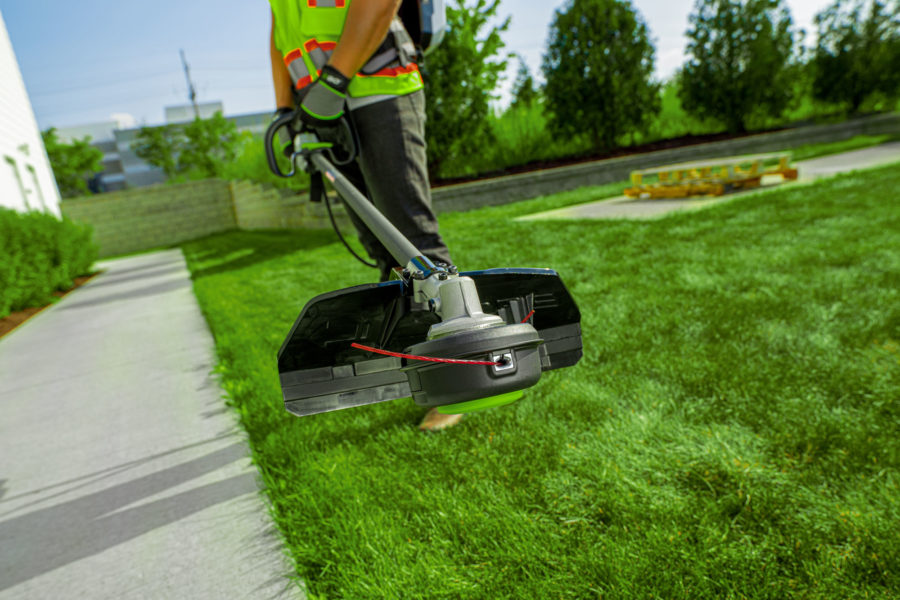
Photo courtesy of EGO POWER+
Better tools may also be part of your next job, especially considering the negative impact of gas-powered outdoor equipment.
According to the California Globe, Assembly Bill 1346 requires the California Air Resources Board (CARB) to prohibit the sale of new gas-powered, small off-road engines commonly found in gardening and outdoor equipment like lawnmowers, leaf blowers, and chainsaws.
“Groundskeepers and landscaping crews no longer have to sacrifice the power of gas when converting to battery,” Gerry Barnaby, senior director of excitement at EGO, told gb&d. He says solutions like the EGO POWER+ platform offer a more sustainable power source, and all tools in the EGO platform match or surpass the power of gas—without the noise, fuss, or fumes.
According to an article by Consumer Reports, cordless tools can also offer public health benefits. “Electric mowers are vastly preferable to gas models because they generate no tailpipe emissions,” says Simon Mui, a Li-ion battery expert at the Natural Resources Defense Council. Compared with gas engines, which emit carbon monoxide and unburned hydrocarbons, “electrics offer a lot of public health benefits,” he says.

